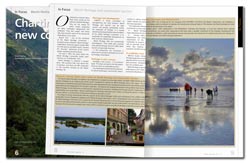At the 1992 Earth Summit in Rio de Janeiro, world leaders agreed that the conservation of biodiversity was one of the cornerstones of sustainable development.
They acknowledged that the world was facing an unprecedented wave of species extinction and the rapid destruction of ecosystems and decided that it was urgent to halt the global loss of biodiversity in order to ensure that we leave a healthy and viable world for future generations. To achieve this, the Rio Summit adopted the Convention on Biological Diversity (CBD). This agreement, which has been adhered to by the vast majority of governments, sets out commitments for maintaining the world’s ecological foundations as economic development accelerates.
The Convention on Biological Diversity completed the international instruments the global community has developed in the run-up and follow-up to the first United Nations Conference on the Human Environment (Stockholm, 1972). The World Heritage Convention was one of the first of these instruments and since its adoption by the General Conference of UNESCO that same year, has made a very important contribution by ensuring the conservation of the most outstanding places for biodiversity and ecosystems. Today, these sites in total cover over 10 per cent of the surface of the global
network of protected areas.
But the battle for conserving world biodiversity is far from won. The 2010 CBD Conference of the Parties adopted a new Strategic Plan for Biodiversity for the next decade, setting out twenty ambitious and specific targets, known as the Aichi Biodiversity Targets. This new plan will be the overarching framework on biodiversity, not only for all the biodiversity-related conventions, including the World Heritage Convention, but for the entire United Nations system.
This issue explores how the World Heritage Convention contributes to achieving these targets, by working in synergy with other site-based instruments. Cultural landscapes and their overlap with protected areas are examined in sites such as Iceland’s Þingvellir (Thingvellir) National Park; Global Geoparks and their affiliation with World Heritage sites, including Messel Pit Fossil Site (Germany); joint Biosphere Reserves and World Heritage sites, such as Socotra Archipelago (Yemen); and Wetlands of International Importance (Ramsar List) that are also World Heritage sites, such as Slovenia’s Škocjan Caves. These articles demonstrate how these different instruments contribute in synergistic and complementary ways towards achieving sustainable development.
Editorial
Kishore Rao
Director of UNESCO’s World Heritage Centre
Contents
In Focus
World Heritage and other conventions
Global to local
How World Heritage sites can bring international conservation goals to ground level
The World Heritage Convention is a remarkably useful mechanism for concrete action in preserving threatened sites, ecosystems and endangered species and ultimately a powerful tool to raise awareness and rally action through focused campaigns.
Cultural landscapes and protected areas
Unfolding the linkages and synergies
Recent research reveals the overlaps and synergies between World Heritage cultural landscapes and IUCN’s global category system for recognizing protected areas, and some of the possible implications.
Global Geoparks and geological World Heritage
A case study from Germany
Global Geoparks and the World Heritage Convention have developed a network of cooperation that integrates local, regional and international partners.
The Ramsar and World Heritage conventions and Slovenia’s Škocjan Caves
The World Heritage Convention and the Ramsar Convention have been working together assisting the Škocjan Caves park in Slovenia in enhancing recognition of the area and its importance locally, nationally and internationally.
Close-Up
Satoyama: harmony between people and nature
Satoyama refers to mosaics of different types of land use that have been shaped through the long-term interactions of communities with their surroundings.
Forum
Interview
Braulio Ferreira de Souza Dias, Executive Secretary of the Convention on Biological Diversity.
Advisory Bodies
World Heritage: beacons of inspiration.
Conventions
UNESCO celebrates 10th anniversary of the 2003 Convention for the Safeguarding of Intangible Cultural Heritage; Preparing nominations for the Safeguarding of the Intangible Cultural Heritage: Caribbean countries strengthen their capacities; Emergency Red List of Syrian antiquities is launched in New York.
News
Preservation
Partners in monitoring; Local communities in New Caledonia; Attack on Pang Sida rangers; Dinaric Karst: the Upstream Process in practice; Modernities in the Arab World; Celebrating cities and development; Bermuda taxes petrol for heritage.
In Danger
Safeguarding Mali’s cultural heritage; Towards the preservation of the Everglades; International Observatory of Syrian Cultural Heritage established.
Outreach
World Heritage youth action camps and Young Guardian Clubs; Heritage for Kids in tablet form; State of conservation at a glance; Walter Santagata (1945–2013); Jaeger-LeCoultre auction benefits Brazilian Atlantic Islands; 1,000 new species; 2013–2014 World Heritage map available; Atlas app includes all World Heritage sites; The Case of the Lost World Heritage, 10th episode.








